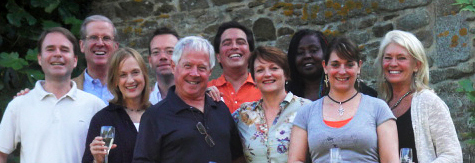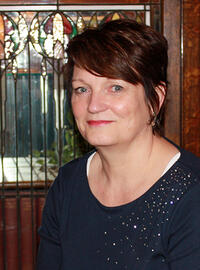Centering Prayer Retreat in Brittany, France
Centering Prayer Retreat in Brittany, France
By Claire Mylanus, Associate Trustee, Brittany, France
About a year ago, I asked Gard Jameson to facilitate a week-long retreat on prayer and worship because I wanted to personally experience worship. I knew that he was capable of doing so because he has his Ph.D. in Comparative Religions, and he teaches at the University of Las Vegas. Gard decided to come to Brittany. He recommended that the retreat participants be English speaking, and he suggested that they be younger readers, preferably potential teachers, between 30 and 40 years of age. The retreat attendees consisted of ten persons: three French persons, one French woman living in the Netherlands, one Mexican man, one English woman, and four persons from the United States.
Each day Gard provided us with a different speaker, and each day Gard led us in the practice of “Centering Prayer.”
Centering Prayer evolved from a discipline practiced by Cistercian monks and was named and popularized by Father Thomas Keating who wrote “Open Mind, Open Heart.” The goal of Centering Prayer is silence, which helps one to communicate more deeply and personally with God and to experience His presence. Centering Prayer is done in silence during sessions of 20 minutes and is personal and different for everyone. This personal communion results in healing emotional issues and in growing the soul because it works at the level of the soul. We have vertical and horizontal relationships. With God we have a vertical relationship, which manifests itself as enhanced capacity to love and to be loved. With others we have a horizontal-social relationship, which involves, among other things, the ministry of forgiveness and service.
It seems to me that Centering Prayer could be compared to worship. God exists behind our thoughts and feelings. Centering Prayer increases our capacity to receive God’s divine presence and to appreciate His nearness.
“Jesus taught his followers that, when they had made their prayers to the Father, they should remain for a time in silent receptivity to afford the indwelling spirit the better opportunity to speak to the listening soul. The spirit of the Father speaks best to man when the human mind is in an attitude of true worship.” (1641.1) 146:2.17
On the second day of the retreat, David Elders, who has been reading The Urantia Book for more than thirty years, dynamically illustrated the new teachings and concepts in The Urantia Book. David showed us how these new concepts are a way for us to learn, to perceive truth, and to experience it in our lives.
Dr. Sadler found 64 new concepts, a few of which we studied. To become cognizant of and to understand these concepts provide a larger framework that enables us to expand our perspective and to see and understand the vision and the plan behind the Urantia Revelation.
We learned that God shares, gives us the tools, and provides us with a means to grow and advance. All new truths evolve from old ones. A number of these new truths contain the potential to enhance our spiritual insight. These include truths related to such topics as: personality bestowal, Thought Adjuster bestowal, mind, the Supreme, the soul, personality survival, and the identity of Jesus.
On the third day of the retreat, Marta Elders, a long- time reader and a clinical psychologist, led us in a study of the soul. We paired off with one other person and participated in “Lectio Divina,” a practice of Benedictine monks in the sixth century. Lectio reveals four aspects of a sacred text:
- Read the sacred text with the eyes (literal appreciation) – share an emerging word.
- Read the text with the mind (reflective appreciation) – share a short thought.
- Read the text with the heart (responsive appreciation) – share a short prayer.
- Read the text with the soul (silence in God’s presence) – share the silence.
Lectio Divina is an excellent aid to the study of The Urantia Book. It enhances one’s understanding and appreciation of the book and the internalization of its teachings. This exercise was special, most importantly, because it gave us a deeper understanding of our partner and allowed for greater communication at a completely different level.
On the fourth day, we studied personality. The goal was to better understand the different types of personality and to identify the potentials of each type. By doing so, we hoped to become more understanding, forgiving, and compassionate toward our fellows.
Carol Schindler, a long- time reader, facilitated our study of personality by presenting the “Enneagram of Personality” from the Enneagram Institute.
According to the book, Wisdom of the Enneagram, there are nine types of personality or identity including the: Triad of Feelings, Triad of Mind, and Triad of Instincts.
It was very interesting because it was an “intermezzo” which enabled us to know ourselves and one another better. The benefits of this are improved relationships with others, better team work, and greater contributions to the Supreme.
All of us really appreciated this retreat. We shared our souls; we experienced brotherhood; and we had beautiful evenings of discussion, good cheer, good meals, enjoyment of life, and profound gratitude for the privilege of this unique experience.

2d row: Gard Jameson, Marc Joly, Luis Garcia- Bory, Ade Awoyinka
